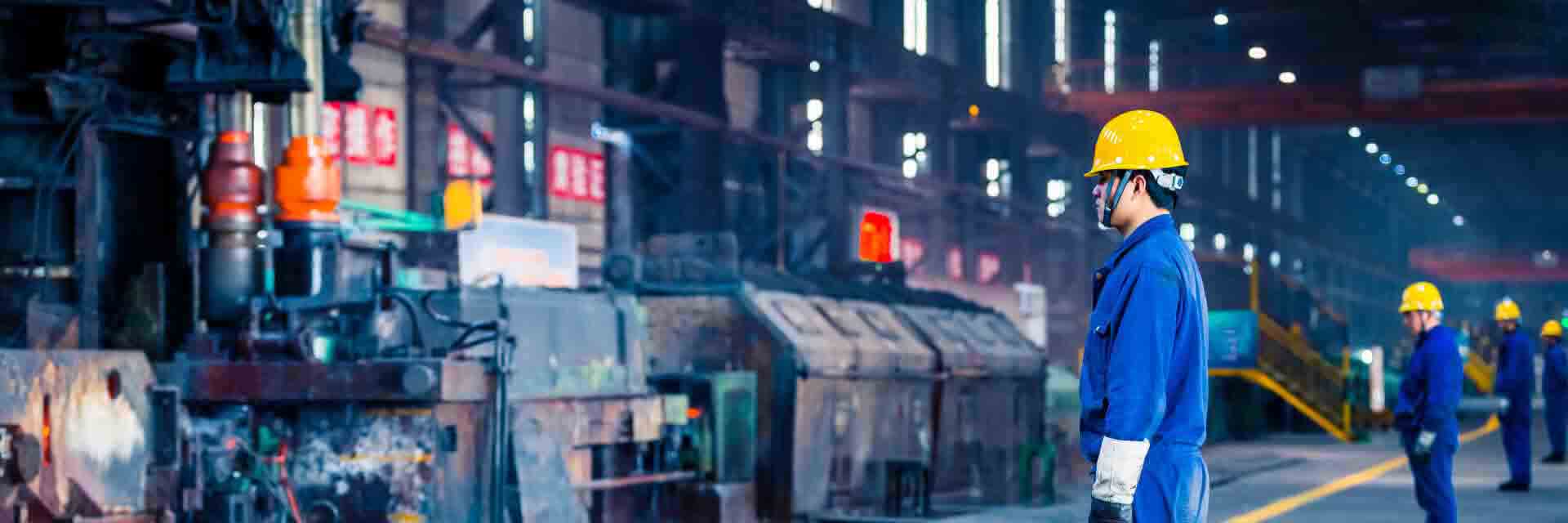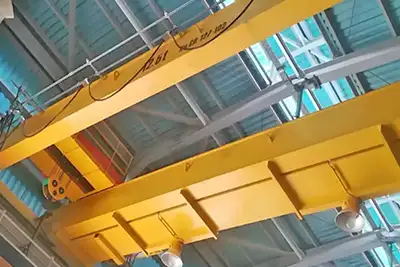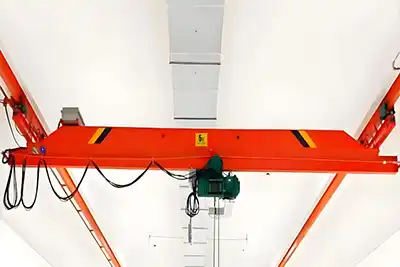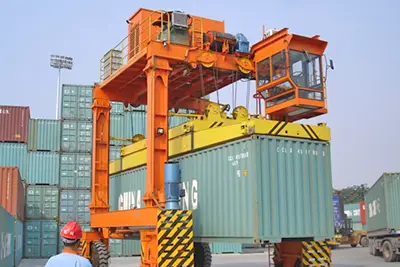10 Key Questions Before Buying a Shipbuilding Gantry Crane
10 Must-Know Questions Before Buying a Shipbuilding Gantry Crane
If you work in shipbuilding, you already know how heavy and oversized the components can be. From large steel hull blocks to entire ship sections, moving these parts safely and efficiently takes serious lifting equipment.
That’s where shipbuilding gantry cranes come in.
These cranes are purpose-built to handle the unique demands of shipyards. They’re big, strong, and customizable. But they’re also a major investment. So before you place an order, it’s important to make sure every detail is covered.
Even small misunderstandings during the inquiry stage can lead to big issues later—wrong span, unsuitable wheel pressure, or a mismatch with your site conditions. These things can slow down your project or cost more to fix after installation.
This guide will help you avoid that.
Who is this for?
If you're responsible for purchasing, specifying, or managing shipyard equipment, this guide is written for you. That includes:
- Procurement managers looking to source the right crane at the right cost
- Project engineers planning the technical details and layout
- Shipyard owners or directors who want to future-proof their operations
We’ll go through 10 practical questions you need to ask or answer before buying a shipbuilding gantry crane. These are based on real cases, and they’ll help you get the right crane from the start.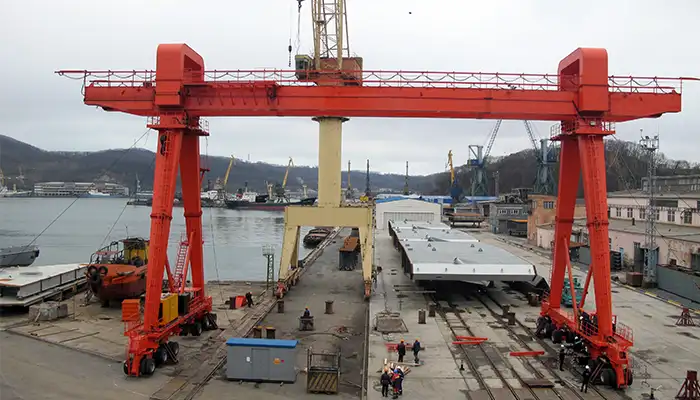
rubber tyred gantry crane for shipbuilding, - rtg shipyard crane
Understanding Your Technical Requirements
Before choosing a shipbuilding gantry crane, you need to match the crane’s specs to your actual work. Not just roughly—but exactly. A mismatch here can cause structural risks, wasted budget, or a crane that simply doesn’t do the job.
Let’s break down the three most important technical questions to get right from the beginning.
1. What is the required lifting capacity, span, and lifting height?
These three numbers are the core of your crane design.
- Lifting capacity means how heavy your heaviest load will be. Don’t guess. Check your biggest block, section, or component. Add some safety margin.
- Span refers to the distance between the rails the crane will run on. This depends on your workshop or yard layout.
- Lifting height is how high the hook needs to go to safely lift and place items.
Why it matters:
- A larger span or lifting height often means a stronger and heavier structure, which increases cost.
- For heavy ship blocks, you might need dual-lift mechanisms or synchronized hoists to keep things balanced.
- If these details are wrong, the whole crane could be unsafe or unusable.
Take your time. Get accurate measurements. Share them clearly with your supplier.
2. What is the allowable maximum wheel pressure on your ground or rails?
Many buyers overlook this—but it’s critical.
- Your crane’s total weight and the weight of the loads will all push down through the wheels.
- If your ground, tracks, or foundation can't handle it, things will crack, sink, or even fail.
How to handle this:
- Ask your civil or structural engineer for the maximum allowable wheel load.
- Share this number with your crane supplier. They’ll adjust the wheel quantity, bogie design, or distribute the load better.
This helps avoid expensive repairs later or the need to reinforce your foundations after installation.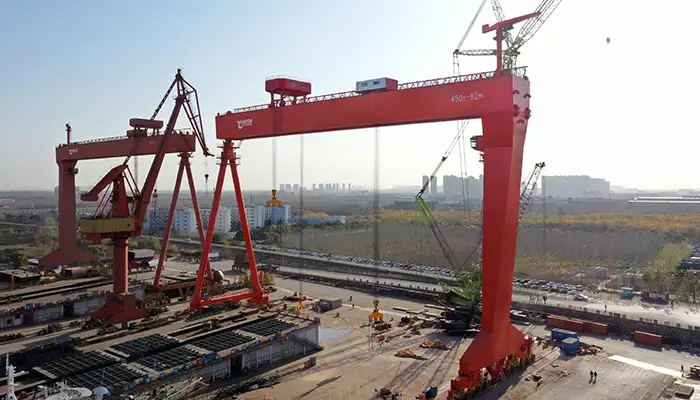
Rail mounted gantry crane for shipbuilding, - rmg shipyard crane
3. What type of material or component will the gantry crane be handling?
Not all loads are the same. A steel plate, a pipe section, and a hull block all behave differently during lifting.
You need to be specific:
- What exactly are you lifting? Hull blocks, bulkheads, steel coils, engine modules?
- What’s their size, shape, weight range, and center of gravity?
Also, does the load need to be rotated or flipped?
- If yes, your crane may need turning devices, rotating spreaders, or custom lifting beams.
- This affects both crane structure and hoist design.
The more your supplier knows about the real job, the better they can design the crane to match it.
Adapting to Your Shipyard Environment
Even the best-designed crane won’t perform well if it doesn’t fit the space or clashes with existing operations. That’s why understanding your actual site conditions is just as important as knowing the technical specs.
Here are three questions that help make sure your gantry crane fits and functions smoothly within your shipyard.
4. Do you have a site layout drawing available?
This is one of the first things your crane supplier will ask for.
- A site layout drawing shows where the crane will be installed and how it fits into your overall production area.
- It helps determine the runway position, crane clearance, and safe access for workers and vehicles.
Why it matters:
- Without a clear layout, there’s a higher risk of interference with buildings, storage areas, or other machines.
- If you’re planning a new crane bay, early layout planning ensures smoother coordination with civil and electrical works.
So, if you have a layout ready—great. If not, now’s the time to start working on one.
5. Is this for a new shipyard or an addition to an existing facility?
This changes how your crane will be designed and installed.
- For a new shipyard, you get more freedom in layout and crane dimensions. You can build the crane and the site together.
- For an existing facility, the crane must be designed to fit what’s already there. That includes runways, columns, buildings, and even traffic paths.
Challenges with retrofitting:
- Limited space or uneven rail alignment
- Old infrastructure that can’t handle higher wheel loads
- Needing to avoid disruption to ongoing production
Knowing this early helps your supplier plan the right installation approach and timeline.
6. What is the available installation space and access at the site?
Crane components are large—some are oversized—and getting them onto your site isn’t always easy.
Key things to check:
- Is there enough open space to unload and assemble the crane?
- Can transport trucks and cranes enter the area without obstruction?
- Are there any height restrictions, tight corners, or weight limits on access roads?
In a crowded or busy shipyard, you might need special equipment or staged assembly plans. Let your supplier know upfront so they can work with your site team and avoid delays later.
Operational and Maintenance Considerations
Once your shipbuilding gantry crane is up and running, it’s essential to think about how it will be used over time. Understanding the operational needs and maintenance demands helps avoid unexpected downtime and ensures smooth long-term performance.
Here are two key questions that will help you plan ahead.
7. Is a maintenance jib crane or auxiliary hoist required?
Sometimes your main gantry crane won’t be enough for all the lifting tasks on-site. That’s where a maintenance jib crane or an auxiliary hoist might come in.
- Maintenance jib cranes are smaller cranes often used for lifting lighter components, spare parts, or equipment for maintenance.
- Auxiliary hoists are smaller lifting units attached to your main crane that handle lighter or smaller items that don’t require the full capacity of the main crane.
Why consider this:
- If you regularly need to replace crane components or perform maintenance, a jib crane can make these tasks safer and quicker.
- It can also help with lifting other equipment, spare parts, or smaller loads, saving time and effort during ship assembly.
Cost vs. convenience:
- While adding a maintenance crane or hoist increases upfront costs, it can save money in the long run. This is because you’ll avoid extra downtime when parts need replacing or smaller components need handling.
- It’s better to plan for this during your crane’s design phase than face delays later.
8. What is the maximum segment weight to be handled during unloading or ship assembly?
Knowing the maximum weight of the segments your crane will handle is crucial for selecting the right hoist, motor, and structural design.
- This weight directly influences the lifting capacity of the crane and whether a single hoist will work or if you’ll need dual hoists to balance the load.
For example:
- For multi-segment assemblies, each segment might not be the heaviest on its own, but when combined, the total weight could be too much for a single hoist to lift safely. In these cases, a dual-lift system might be necessary to handle the load.
- Hoist motor size will need to be adjusted depending on the segment weight, ensuring the crane can handle maximum loads without stress.
It’s crucial to determine the maximum weight you’ll lift and account for it in the design phase. Overloading or mismatched hoist power can lead to operational inefficiencies and even equipment failure.
Logistics and Onsite Support
When it comes to delivering and installing a shipbuilding gantry crane, there’s more to consider than just the technical specs. The logistics and onsite support are critical to making sure everything goes smoothly and stays on schedule.
Let’s take a look at two key questions to help plan for the installation process.
9. What are the road and transport conditions from the port to the installation site?
Getting the crane components from the port to your site might seem straightforward, but it can be tricky. Cranes, especially large gantry cranes, often require special logistics.
Here’s what to check:
- Oversized component transport feasibility: Cranes are huge, and their parts may be too large for regular transport routes. You’ll need to check whether your local roads and infrastructure can handle oversized loads.
- Terrain: If your site is in a remote area or the road conditions are poor, additional planning is necessary. Unpaved or winding roads could complicate transport and assembly.
- Permits and regulations: Transporting oversized crane parts often requires special permits from local authorities. Make sure you account for the time and cost needed to get these permits. Some areas also have weight limits on roads or bridges that you need to plan around.
- Route planning: You need to choose the safest and most efficient route from the port to your site. The logistics team should work with your supplier to plan this in advance, ensuring that delivery delays don’t affect your installation schedule.
Make sure you talk to your supplier early about transport needs and routes. This helps avoid last-minute surprises that could delay installation.
10. What resources can the client provide during installation and commissioning?
The crane installation and commissioning process is a big job, and you’ll need resources to support the process. The more you can provide, the smoother the installation will go.
Here’s what to consider:
- Skilled workers: Are there local teams with the necessary skills for assembly, electrical setup, and testing? Or will you need to bring in specialized technicians from the supplier’s team?
- Lifting tools and equipment: Will you provide your own cranes, hoists, or forklifts for lifting crane components into place, or will the supplier need to bring in extra equipment?
- Scaffolding and temporary structures: Depending on crane size and the installation area, scaffolding or temporary structures might be necessary to support assembly.
The supplier will also need to know what to expect from your team:
- Collaboration expectations: Clear communication and teamwork between the client (you) and the supplier are key. You should discuss the project timeline, installation team roles, and the required resources from both sides.
- Onsite coordination: Make sure there’s a clear plan for daily coordination between workers and suppliers to avoid bottlenecks or delays during installation.
Having a clear plan for installation resources can save you time and money, making sure everything is ready when your crane arrives.
Conclusion
How Answering These Questions Helps Streamline Crane Design, Delivery, and Installation
Choosing the right shipbuilding gantry crane is no small task. By answering these 10 key questions, you’ll make sure that your crane fits perfectly with your site, operations, and long-term needs. This upfront work helps you:
- Ensure accurate crane specs that match your production needs.
- Prevent installation delays by addressing site and transport challenges in advance.
- Improve operational efficiency by designing a crane that’s tailored to your specific materials and processes.
- Save money by avoiding costly changes or repairs later.
The more you understand your needs and site conditions, the smoother your crane’s design, delivery, and installation will be.
Encourage Early Communication with Your Supplier
It’s important to start the conversation with your crane supplier early. Share as much detail as possible about your site, operations, and expectations. This will give them the time to propose the best solutions, customize the crane design, and plan logistics properly.
The better the collaboration at this stage, the smoother things will be throughout the project.
Final Advice: Choose a Manufacturer Who Can Offer Technical Consultation, Customization, and After-Sales Service
Choosing the right manufacturer is just as crucial as getting the right crane. Look for a supplier who:
- Provides technical consultation: They should be able to help you solve any challenges and customize the crane to your specific needs.
- Offers customization options: Your crane should be flexible enough to evolve with your needs as your shipyard grows.
- Supports you with after-sales service: A good supplier doesn’t disappear after delivery. They should offer maintenance, spare parts, and support to keep your crane running smoothly for years.
By asking the right questions and partnering with the right supplier, you set yourself up for success, both now and in the future.

